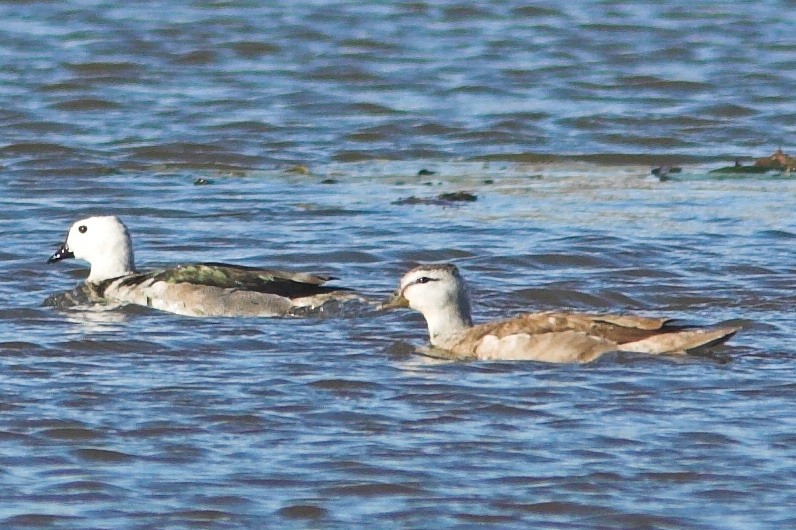Cotton Pygmy Goose
A species of Pygmy Geese Scientific name : Nettapus coromandelianus Genus : Pygmy Geese
Cotton Pygmy Goose, A species of Pygmy Geese
Botanical name: Nettapus coromandelianus
Genus: Pygmy Geese
Content
Description General Info
 Photo By Glen Fergus , used under CC-BY-SA-2.5 /Cropped and compressed from original
Photo By Glen Fergus , used under CC-BY-SA-2.5 /Cropped and compressed from original Description
Small individuals of this species are the smallest waterfowl on earth, at as little as 160 g (5.6 oz) and 26 cm (10 in). The goose-like bill is short and deep at the base. Males have a dark brown forehead and crown and a blackish green broad collar at the base of the neck. The sides of the head and neck are whitish. The back, wing coverts and scapulars are dark brown with green and purple gloss. The female has a duller cap and a brown line through the eye. The collar is replaced by spots and the face is flecked and neck finely vermiculated unlike the male. The non-breeding or eclipse male resembles the female except that it has the broader white wing band. In flight the male has dark wings with white flight feathers tipped in black. The female has dark wings and a white trailing edge to the secondaries and a few inner primaries. They have a red iris and black legs (greenish in breeding males) and bill. Downy chicks have white superciliary stripes that meet at the back of the head which is black. A short dark eye stripe is present on the whitish face. The upperside of the neck is grey. The mantle is grey brown and two white patches are present on the scapulars. The tail is dark grey to black. The underside is buff. The hind toe is narrowly lobed. The nostril is small and oval and opens close to the base of the commissure of the bill. 
Size
38 cm
Nest Placement
Floating
Feeding Habits
Cotton Pygmy Goose primarily consumes seeds, aquatic plant parts, and some invertebrates like insects. They forage by dabbling among floating vegetation, with unique head-flattening behavior. While common in pairs or small flocks, they form larger groups seasonally.
Habitat
Cotton Pygmy Goose thrives in warm freshwater habitats such as vegetated pools, lakes, and marshes. Favoring areas with substantial floating and submerged vegetation, these birds adapt to seasonal water fluctuations by dispersing. Their habitat extends from small village ponds to expansive wetlands and includes seasonal migrations, expanding westward during winter.
Dite type
Omnivorous
General Info
Feeding Habits
Bird food type
Behavior
Several pairs of the bird may forage in close proximity on a single waterbody. Large flocks form in winter and a flock of nearly 6000 was recorded at Chilka lake. This species feeds mainly at the surface of the water. Stomach analysis showed that they fed on small fishes Puntius, Mystus, Oryzias, molluscs, crustaceans, insect larvae as well as plant matter from species such as Ipomoea, Hydrilla and Ruppia. They do not dive or up-end and take to flight from the water surface without having to run or patter on the surface. They fly swiftly, often low over water, and are agile enough to escape falcons. Courtship displays are largely undocumented but a post-copulatory display involves the male arching neck, displaying the white neck feathers and the white wing patches. They pair up during the breeding season which is mainly during the rains (monsoons in June–August India and January to March in Australia) and build their nests mainly in natural tree hollows, such as tree trunks. The males assist in locating nests but incubation is thought to be by the female alone which lays 6 to 12 ivory-colored eggs per clutch. The nest may as high as five metres from the ground and chicks leap off to follow their parents into water. Larger clutches have been recorded and are thought to be due to intraspecific brood-parasitism. Rock pythons have been recorded preying on cotton teal. Plasmodium circumflexum was found in their blood of a specimen examined in Bangladesh. Three species of parasitic cestode Hymenolepis smythi, H. fista and Retinometra fista are known from hosts of the species. The trematode Cyclocoelum sp. was recorded as a parasite in Queensland. Paramonostomum thapari was described from a cotton teal. 
Distribution Area
This species is widely distributed across Asia, its distribution extending to Australia. Population move in response to rain and water availability. Some populations disperse further in summer (and are found only seasonally, for instance in Afghanistan). Winter dispersal is also wide and individuals have been seen as far west as Arabia, and Jordan and they are regularly found on islands in the region such as the Maldives and the Andamans. They are found especially in lakes and ponds with emergent vegetation amid which they forage. They can be found even in small village ponds in South Asia. In Australia they are found mainly in lagoons. They are said to roost on trees. 
Species Status
Not globally threatened.
Scientific Classification
Phylum
Chordates Class
Birds Order
Waterfowl Family
Geese Genus
Pygmy Geese Species
Cotton Pygmy Goose